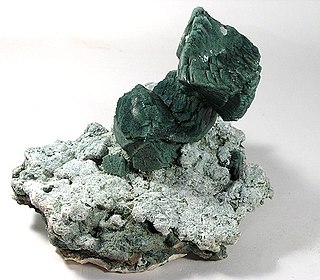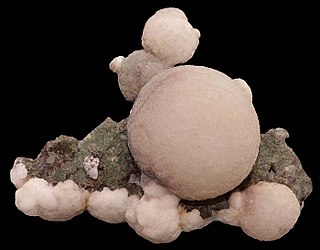
Analcime (; from Ancient Greek ἀνάλκιμος (análkimos) 'not strong') or analcite is a white, gray, or colorless tectosilicate mineral. Analcime consists of hydrated sodium aluminium silicate in cubic crystalline form. Its chemical formula is NaAlSi2O6 · H2O. Minor amounts of potassium and calcium substitute for sodium. A silver-bearing synthetic variety also exists (Ag-analcite). Analcime is usually classified as a zeolite mineral, but structurally and chemically it is more similar to the feldspathoids. Analcime is not classified as an isometric crystal, as although the crystal structure appears to be isometric, it is usually off only by a fraction of an angle. However, there are truly isometric samples of the mineral, which makes its classification even more difficult. Due to the differences between the samples being too slight, there's no merit from having multiple species names, so as a result analcime is a common example for minerals occurring in multiple crystal systems and space groups. It was first described by French geologist Déodat de Dolomieu, who called it zéolithe dure, meaning hard zeolite. It was found in lava in Cyclops, Italy. The mineral is IMA approved, and had been grandfathered, meaning the name analcime is believed to refer to a valid species til this day.

Chabazite is a tectosilicate mineral of the zeolite group, closely related to gmelinite, with the chemical formula (Ca,K
2,Na
2,Mg)Al
2Si
4O
12•6H
2O. Recognized varieties include Chabazite-Ca, Chabazite-K, Chabazite-Na, and Chabazite-Sr, depending on the prominence of the indicated cation.

Wardite is a hydrous sodium aluminium phosphate hydroxide mineral with formula: NaAl3(PO4)2(OH)4·2(H2O). Wardite is of interest for its rare crystallography. It crystallizes in the tetragonal trapezohedral class and is one of only a few minerals in that class. Wardite forms vitreous green to bluish green to white to colorless crystals, with pyramidal {102} or {114} faces and with {001} usually present masses. Also appera as fibrous encrustations. It has a Mohs hardness of 5 and a specific gravity of 2.81–2.87.

Natrolite is a tectosilicate mineral species belonging to the zeolite group. It is a hydrated sodium and aluminium silicate with the formula Na2Al2Si3O10·2H2O. The type locality is Hohentwiel, Hegau, Germany.

Datolite is a calcium boron hydroxide nesosilicate, CaBSiO4(OH). It was first observed by Jens Esmark in 1806, and named by him from δατεῖσθαι, "to divide," and λίθος, "stone," in allusion to the granular structure of the massive mineral.

Pectolite is a white to gray mineral, NaCa2Si3O8(OH), sodium calcium hydroxide inosilicate. It crystallizes in the triclinic system typically occurring in radiated or fibrous crystalline masses. It has a Mohs hardness of 4.5 to 5 and a specific gravity of 2.7 to 2.9. The gemstone variety, larimar, is a pale to sky blue. There is also a whitish form of the mineral from Alaska that is sometimes marketed as 'Alaska jade'.

Heulandite is the name of a series of tecto-silicate minerals of the zeolite group. Prior to 1997, heulandite was recognized as a mineral species, but a reclassification in 1997 by the International Mineralogical Association changed it to a series name, with the mineral species being named:

Mordenite is a zeolite mineral with the chemical formula, (Ca, Na2, K2)Al2Si10O24·7H2O. and it is one of the six most abundant zeolites and is used commercially.

Gmelinite-Na is one of the rarer zeolites but the most common member of the gmelinite series, gmelinite-Ca, gmelinite-K and gmelinite-Na. It is closely related to the very similar mineral chabazite. Gmelinite was named as a single species in 1825 after Christian Gottlob Gmelin (1792–1860) professor of chemistry and mineralogist from Tübingen, Germany, and in 1997 it was raised to the status of a series.
Gmelinite-Na has been synthesised from Na-bearing aluminosilicate gels. The naturally occurring mineral forms striking crystals, shallow, six sided double pyramids, which can be colorless, white, pale yellow, greenish, orange, pink, and red. They have been compared to an angular flying saucer.

Cavansite, named for its chemical composition of calcium vanadium silicate, is a deep blue hydrous calcium vanadium phyllosilicate mineral, occurring as a secondary mineral in basaltic and andesitic rocks along with a variety of zeolite minerals. Its blue coloring comes from vanadium, a metal ion. Discovered in 1967 in Malheur County, Oregon, cavansite is a relatively rare mineral. It is polymorphic with the even rarer mineral, pentagonite. It is most frequently found in Pune, India, and in the Deccan Traps, a large igneous province.

Celadonite is a mica group mineral, a phyllosilicate of potassium, iron in both oxidation states, aluminium and hydroxide with formula K(Mg,Fe2+
)(Fe3+
,Al)[Si
4O
10](OH)
2.

Thomsonite is the name of a series of tecto-silicate minerals of the zeolite group. Prior to 1997, thomsonite was recognized as a mineral species, but a reclassification in 1997 by the International Mineralogical Association changed it to a series name, with the mineral species being named thomsonite-Ca and thomsonite-Sr. Thomsonite-Ca, by far the more common of the two, is a hydrous sodium, calcium and aluminium silicate, NaCa2Al5Si5O20·6H2O. Strontium can substitute for the calcium and the appropriate species name depends on the dominant element. The species are visually indistinguishable and the series name thomsonite is used whenever testing has not been performed. Globally, thomsonite is one of the rarer zeolites.

Mesolite is a tectosilicate mineral with formula Na2Ca2(Al2Si3O10)3·8H2O. It is a member of the zeolite group and is closely related to natrolite which it also resembles in appearance.

Pollucite is a zeolite mineral with the formula (Cs,Na)2Al2Si4O12·2H2O with iron, calcium, rubidium and potassium as common substituting elements. It is important as a significant ore of caesium and sometimes rubidium. It forms a solid solution series with analcime. It crystallizes in the isometric-hexoctahedral crystal system as colorless, white, gray, or rarely pink and blue masses. Well-formed crystals are rare. It has a Mohs hardness of 6.5 and a specific gravity of 2.9. It has a brittle fracture and no cleavage.

Brewsterite is the name of a series of tectosilicate minerals of the zeolite group. Prior to 1997, brewsterite was recognized as a mineral species, but a reclassification in 1997 by the International Mineralogical Association changed it to a series name, with the mineral species being named brewsterite-Sr and brewsterite-Ba. Brewsterite-Sr, the more common of these, is a hydrous strontium and aluminium silicate, (Sr,Ba)2Al4Si12O32·10H2O. Small amounts of barium is usually present replacing part of the strontium. The appropriate species name depends on the dominant element. The species are visually indistinguishable, and the series name brewsterite is still used whenever testing has not been performed.

Portlandite is a hydroxide-bearing mineral typically included in the oxide mineral class. It is the naturally occurring form of calcium hydroxide (Ca(OH)2) and the calcium analogue of brucite (Mg(OH)2).

Thaumasite is a calcium silicate mineral, containing Si atoms in unusual octahedral configuration, with chemical formula Ca3Si(OH)6(CO3)(SO4)·12H2O, also sometimes more simply written as CaSiO3·CaCO3·CaSO4·15H2O.
Paulingite or paulingite-K is a rare zeolite mineral that is found in vesicles in the basaltic rocks from the Columbia River near Rock Island Dam, Washington.

Okenite (CaSi2O5·2H2O) is a silicate mineral that is usually associated with zeolites. It most commonly is found as small white "cotton ball" formations within basalt geodes. These formations are clusters of straight, radiating, fibrous crystals that are both bendable and fragile. It also belongs to the family of the calcium silicate hydrates (C-S-H) commonly found in hardened cement paste. In cement chemist notation (CCN) it is noted as CaO·2SiO2·2H2O and abbreviated as CS2H2.
Zeolites are found in several locations in southern and central Idaho.


















